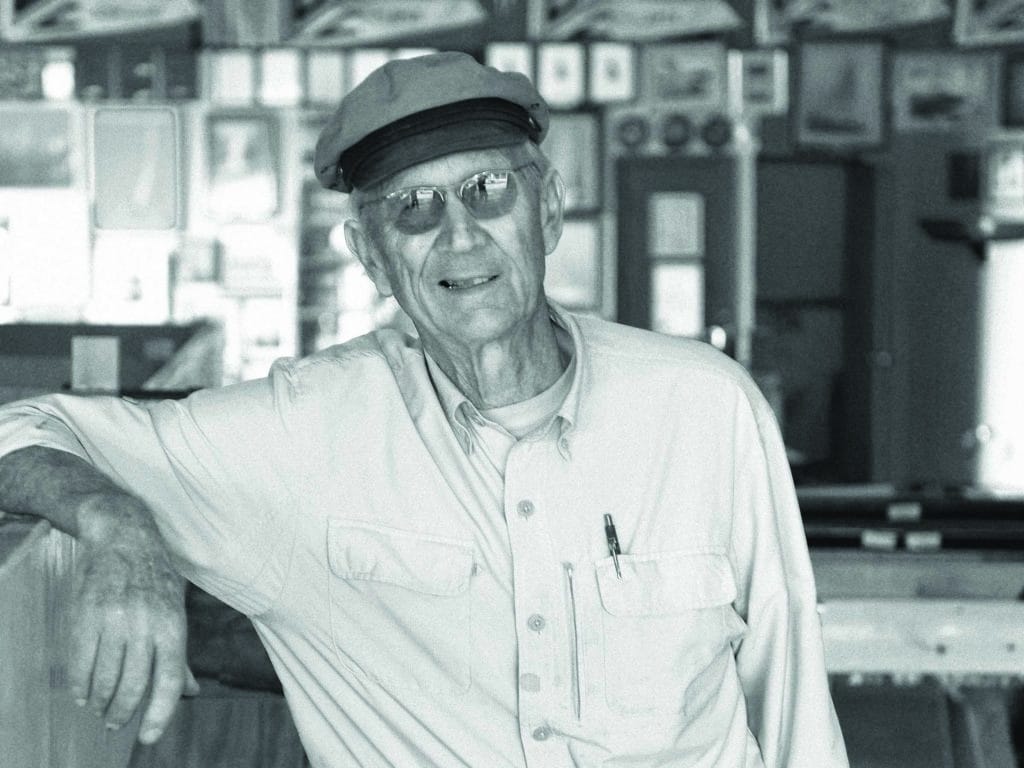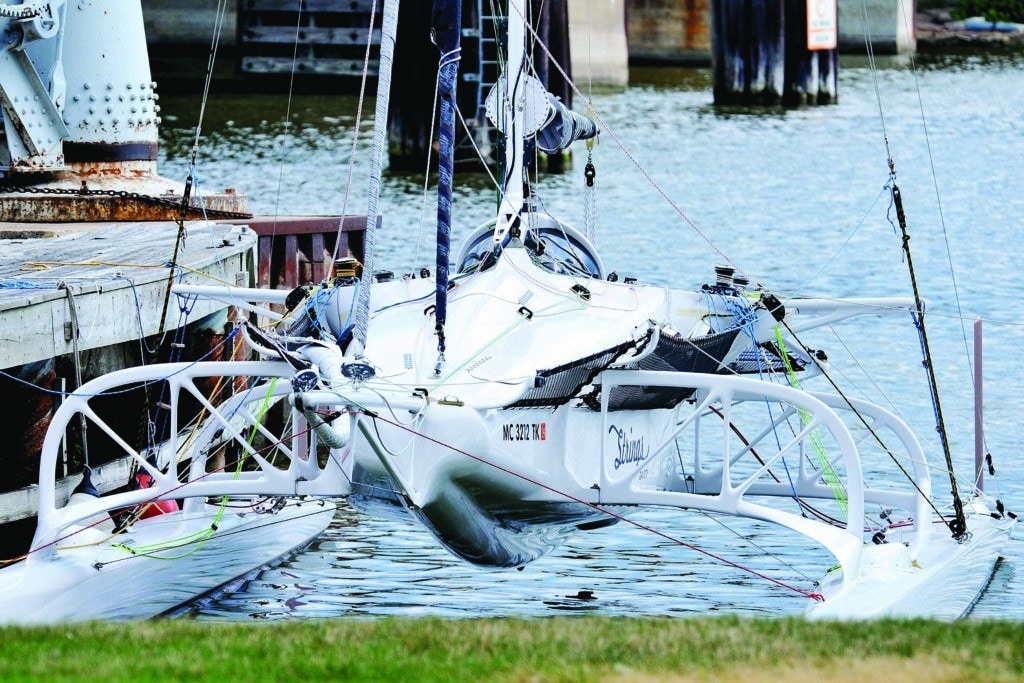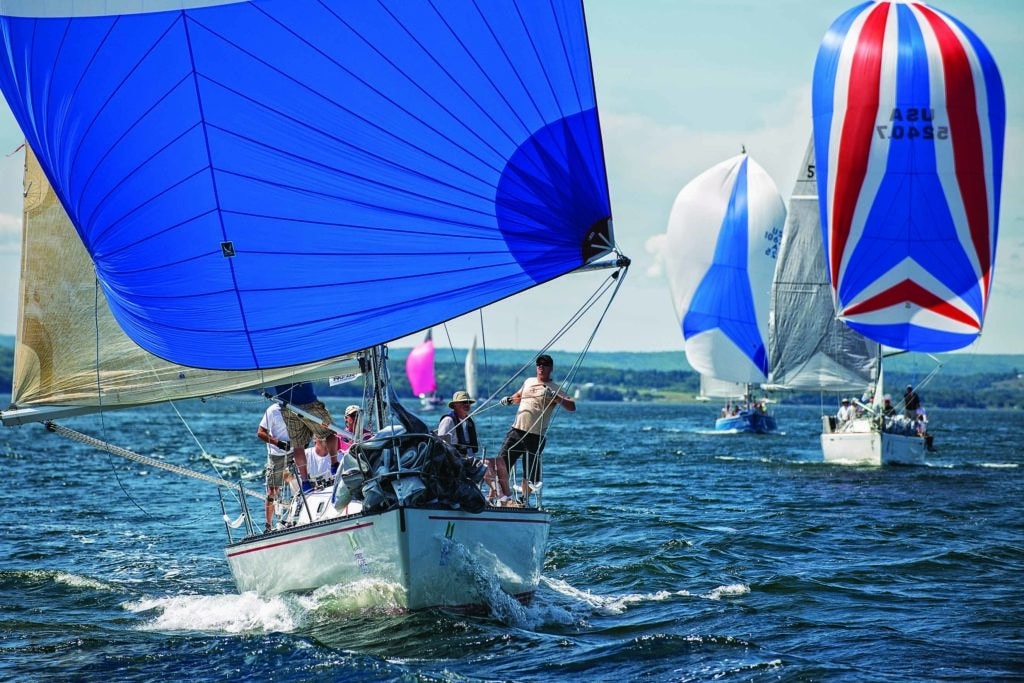Meade Gougeon passed away on August 27, 2017. A pioneer into his final days, Gougeon, at 78, won his division in the 2017 Everglades Challenge endurance race. An excellent tribute from reporter Andrew Dodson at Gougeon’s hometown Bay City News is here. The following story was originally published in 2014.

Wearing a short-brimmed captain’s hat and dressed in khaki, Meade Gougeon looks like he just stepped off the deck of a navy ship—not with the tentativeness of a midshipman, but the confidence of an officer—moving with an agility and pace that belie his 75 years. Perhaps it’s the cycling or the swimming; maybe it’s his training program. He has a reclining chair at home and another in the office at his boat shop. He’ll catch 30 to 40 minutes of sleep in one or the other, maybe twice a day. OK, I know what you’re thinking, but there’s more to the story. He also sleeps only five hours a night and maintains this regime year-round. The reason? The Florida Everglades Challenge, a grueling 300-mile race that takes competitors over the open waters of the Gulf and through parts of the Everglades National Park.
“There are some guys who go for three days and don’t sleep a wink, but I think that’s reckless,” says Meade. “When you get over-fatigued, that’s when you start making mistakes.”
Hence Meade’s “catnap” program. When he needs to recharge, he heaves to, anchors, or sets a sea anchor. A half-hour later, he’s back in the game. The paddling chair in his boat reclines, so he fully simulates race mode when sound asleep at the boat shop or at home. “I can nod off for 30 to 40 minutes, wake up, and feel great. I’ve got that down pretty pat.”
The race, which is both paddled and sailed, can take as long as eight days to complete—if you’re one of the 40 percent of starters who actually finish. Meade has entered four times, but been one of the fortunate 40 percent just once—in 2011, racing with his brother, Jan. They finished sixth out of around 80 boats.
But what has really put Meade and, more specifically, the Gougeon name on the map is his line of epoxies and epoxy-related products. Sold as West System, Gougeon adhesion and coating products have revolutionized boatbuilding and repair for professionals as well as amateurs. Like his nontraditional training approach to the Everglades Challenge, Gougeon products were born out of a willingness to break with tradition.
Raised on Saginaw Bay, Mich., just after World War II, Meade and his two brothers, Joel and Jan, got into boatbuilding early on. “At the beginning of the summer, we’d get hammers and nails and buy some pitch and make scows or whatever else we could build,” recalls Meade.
From there, they enrolled in a technical high school. “We had a whole range of courses, so by the time we were 17, we knew how things were made.” Then followed an engineering degree for Joel, business school for Meade, and building apprenticeships for Jan, all of which sent the three on a trajectory that would soon establish them as one of the most known names in boatbuilding.
In the 1960s, Meade was working as a sales engineer for U.S. Graphite in Erie, Pa., and campaigning his trimaran, Victor T, in the C-Class multihull fleet, an untraditional move in a fleet composed almost entirely of catamarans. It was especially lethal in light winds. “It was giving the C guys fits,” Meade recalls. “I couldn’t go to weather with the other guys, but it decimated them downwind.”

His work caught the attention of Dave Hubbard, who designed a string of successful catamarans, a number of which eventually defended the Little America’s Cup. Hubbard recalls, “At the time my brother and I had designed a D-shaped wing mast for Alliance, a catamaran we were building for Van Allen Clarke. We asked Meade because he worked very well in wood; he was a real craftsman.” Meade stayed at Hubbard’s house for a few weeks and built the wing. Alliance was retired a few years later, and Meade’s D-mast went into storage in a barn in Vermont. “Just this past summer, we were clearing things out and finally cut it up and got rid of it,” says Hubbard. “We thought of Meade. He was such a nice, gentle, easy-going guy.” Meade’s experience working with Hubbard dramatically expanded Meade’s circle of contacts. “As I look back on my career, that was a key, having met all the people in the multihull movement on the East Coast,” says Meade.
In 1969, Meade teamed up with brother Jan to form Gougeon Brothers, Inc., where they kept the lights on by building DN iceboats while also working on a 35-foot trimaran, Adagio. His brother, Joel, had just returned from Vietnam and had $10,000 he was planning to spend on a new house, but Meade and Jan convinced him to instead buy into their company. “His wife wasn’t too happy about it at the time, but she changed her mind later on,” remembers Meade.
Apart from the formation of their new company, 1969 proved a pivotal year for the three brothers on the technological front. “We were buying epoxy from the same company that was selling it to pattern-makers,” says Meade. “It was a thicker, pasty stuff which worked fine as a glue, but there was no knowledge or understanding of it as a coating.”
Coating, or sealing, keeps wood from absorbing moisture, and the problem was maintaining the physical properties of both bonding and sealing. Herbert Dow, at Dow Chemical’s world headquarters, located just 17 miles west of the Gougeon brothers’ shop, got wind of what they were doing and paid them a visit. Meade recalls, “One of their guys asked, ‘How much do you know about chemistry?’ and I said, ‘Well, I took a chemistry course once.’ He said, ‘Here are the ingredients I suggest you look at, here’s where you can purchase them, and this is where you start with the ratios.’ So, I became a bench chemist. The adhesive part was easy, but the coating was a real challenge. Before long, we had a resin that could both bond and seal as the boat was being built.”
In 1970, Adagio was launched. A radical step in boat construction, she had been built using epoxy as a sealer as well as an adhesive and incorporated very few fasteners. Still competing, it weighs 2,300 pounds and has a PHRF rating of minus 63. Except for some broken battens, Adagio went through a blast of almost 70 mph unscathed in the 2002 Chicago-Mackinac Race. According to Meade, it’s the perfect long-term test bed for the longevity of wood/epoxy structures.
Next came a keelboat for a customer in Detroit, one that Meade admits “was halfway fast, but let’s just say we were not as up to speed in the keelboat world as we were in the multihull world.” Then it was back to DNs and C-class trimarans. At that point, the WEST System, as a name, still didn’t exist. “Local guys were stopping in to see what we were up to and wanted to buy the stuff. So we’d weigh it and put it in Mason jars.” That eventually gave way to pumps, which would more precisely meter the necessary ratio of resin to hardener and make it much more accessible for the general public.

Meade Gougeon passed away on August 27, 2017, at the age of 78. I pioneer into his final year, Gougeon won his division in the windy 2017 Everglades Challenge. An excellent tribute from reporter Andrew Dodson, from Gougeon’s home town Bay City News is at here
In 1971, the WEST System as a product was established, and Meade started pedaling it in small ads in the back of boating magazines that touted epoxy resin as a way to “solve the problems that wood has as an engineering material,” offering the WEST manual for $1. “Wooden Boat magazine wouldn’t take my ad,” Meade recalls. “They thought I was putting wood down as an engineering material and that I was being cocky about having a solution.” Today, Meade estimates that about 95 percent of the boats featured in Wooden Boat are built using epoxy.
1975 was another watershed year with their construction of Golden Daisy, a Ron Holland-designed 2-tonner that successfully defended the Canada’s Cup. “That opened up the whole thing,” says Meade. But, it came with unexpected consequences. “All of a sudden, the world discovered there was another way to build boats with epoxy, and we became the gurus who knew all about it. The phone was ringing off the hook. We were hearing more and more about disasters happening with our product. Ninety percent were doing just fine, but if you have 10 percent who aren’t happy, you can’t survive in any area.”
The solution? “In 1978, I said, ‘Joel, you run the place; Jan, you build the boats. I’m out of here.’ I locked myself in a trailer for six months and wrote the boatbuilding book. I had to. I couldn’t focus on anything else, from morning to night, day after day after day. That was absolutely the most mentally difficult thing I’ve ever done in my life. When I got that done, I couldn’t write a letter; I couldn’t write anything for several months.” That book, “The Gougeon Brothers on Boat Construction,” has become the bible for boatbuilders around the world. The first edition was 320 pages, and the initial press run of 7,500 copies sold out in six months. In its expanded fifth edition, the book still sells 6,000 to 7,000 yearly.
In line with his modest nature, Meade’s name was not on the earlier editions. “It was the Gougeon brothers. I wrote it, but Joel and Jan contributed. I didn’t need the accolades. I could care less. All I wanted to do was get it done. I didn’t want to be in the spotlight. Years later, when we went to a major revision—it’s now 400 pages—there was a universal agreement: Meade, you’re the guy who wrote this book. You’ve got to have your name on it.” He reluctantly agreed.
In the 1980s, the brothers supplemented their boatbuilding and epoxy company by building wind turbine blades. At that point, American-built windmills were using two blades. “We had the lightest-weight, strongest blades, never had a failure, and built around 4,600 of them,” says Meade. “But that wasn’t good enough because what you bolted them through with just wasn’t working very well.” Part of the problem was the speed of the two blades. “It was getting up close to the speed of sound, and nobody wanted that noise in their backyard,” says Meade. Then, the Danes entered the market with three-blade technology, which reduced the speed by 50 percent, and in 1987, the bottom fell out of the American industry. “We were right in it up to our eyeballs, thinking this is going to be the deal, and we were going to help save the world with wind energy, and it turned out to be a $3.5 million lesson in risk management. But we survived.”
The whole project came with some costs. Joel had left the business in 1984 for a career in politics. Jan started having health issues and went into semi-retirement, spending his days tinkering in the boat shop and leaving Meade to take care of the day-to-day issues. In 2001, Meade suffered a mild heart attack, and he, too, retired to the boat shop. “I like to say Jan and I successed our way back to the boat shop. I spent about 25 years in the office, running the place. After the heart attack, I had to get off the treadmill.”
Together again in the shop, Meade and Jan launched into a number of projects, including the radical 40-foot trimaran Strings. Like some of their earlier trimaran designs, such as the Gougeon 32, this boat was self-rescuing, and Meade credits his brother for coming up with their ingenious system for righting trimarans. “Jan, who had not gone to college at all, was actually the best out of all of us, really diving into engineering issues and coming up with solutions,” says Meade. “He had a very intuitive nature.”
Like Meade, Jan’s passions were multihulls and iceboats, and Jan was successful in both realms, winning four DN world championships and three singlehanded Port Huron to Mackinac races. He died in late 2012.
What has kept Meade going in the boat business for almost six decades? “If we were just building one type of boat, I think it would get pretty boring, but all of a sudden I discover sailing canoes, and I lay awake nights thinking about how I’m going to build a good sailing canoe. With iceboats, after a while, it just drove us nuts. We were building 50 parts of this piece and 50 parts of that piece, and turning out three a day. It wasn’t nearly as much fun as just taking on a project, such as Golden Daisy. Everything was new, and you had to have your thinking cap on all the time; it was a challenge, and you looked forward to coming to work. And, I think that’s still the challenge. We’re challenged by problem solving. Maybe we’re like our ancestors. The happiest guys were the successful tool builders, the ones who made everything easier, better. You feel good about it when you think of an idea and wonder why you didn’t think of that 12 years ago.”
It’s a Friday morning in July, the tall ships are visiting Bay City, Mich., and the employees have been given the day off to take it all in. The original shop, where the trimarans and Golden Daisy were built, and where the formulation of WEST epoxy was first mixed, is across a narrow street from the Gougeon factory, on the banks of the Saginaw River, which flows into Lake Huron. Meade’s finishing breakfast and getting ready for the rest of the day. Earlier, he paddled down the river to see the tall ships. “You can’t get any closer on the water than 300 feet from any of the ships,” says Meade. “They think you might have a bomb or something. So, I got here at 7 a.m. and paddled my ass down there. People were just waking up on the boats, and I got up close. On my way back, here comes the whole flotilla of Coast Guard boats. I waved and yelled, ‘Hi guys! How’re you doin’?” No doubt the reclining-chair training has paid off. Perhaps more training will soon be in order.









